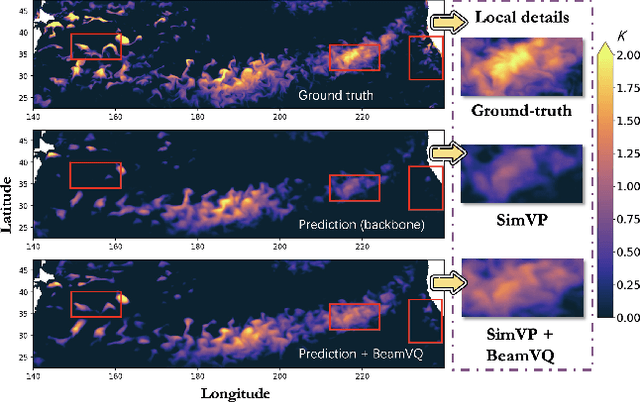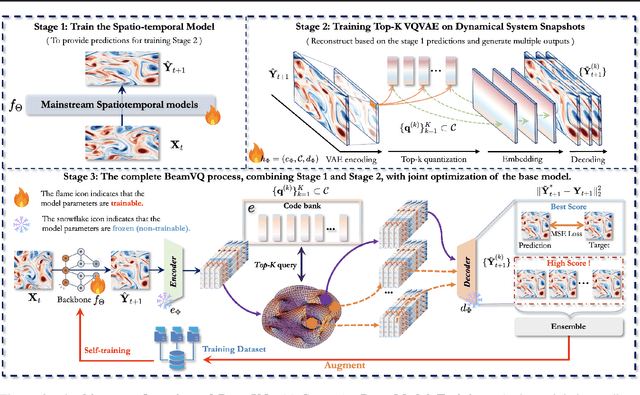Xiaomeng Huang
NeuralOM: Neural Ocean Model for Subseasonal-to-Seasonal Simulation
May 27, 2025Abstract:Accurate Subseasonal-to-Seasonal (S2S) ocean simulation is critically important for marine research, yet remains challenging due to its substantial thermal inertia and extended time delay. Machine learning (ML)-based models have demonstrated significant advancements in simulation accuracy and computational efficiency compared to traditional numerical methods. Nevertheless, a significant limitation of current ML models for S2S ocean simulation is their inadequate incorporation of physical consistency and the slow-changing properties of the ocean system. In this work, we propose a neural ocean model (NeuralOM) for S2S ocean simulation with a multi-scale interactive graph neural network to emulate diverse physical phenomena associated with ocean systems effectively. Specifically, we propose a multi-stage framework tailored to model the ocean's slowly changing nature. Additionally, we introduce a multi-scale interactive messaging module to capture complex dynamical behaviors, such as gradient changes and multiplicative coupling relationships inherent in ocean dynamics. Extensive experimental evaluations confirm that our proposed NeuralOM outperforms state-of-the-art models in S2S and extreme event simulation. The codes are available at https://github.com/YuanGao-YG/NeuralOM.
Advanced long-term earth system forecasting by learning the small-scale nature
May 26, 2025Abstract:Reliable long-term forecast of Earth system dynamics is heavily hampered by instabilities in current AI models during extended autoregressive simulations. These failures often originate from inherent spectral bias, leading to inadequate representation of critical high-frequency, small-scale processes and subsequent uncontrolled error amplification. We present Triton, an AI framework designed to address this fundamental challenge. Inspired by increasing grids to explicitly resolve small scales in numerical models, Triton employs a hierarchical architecture processing information across multiple resolutions to mitigate spectral bias and explicitly model cross-scale dynamics. We demonstrate Triton's superior performance on challenging forecast tasks, achieving stable year-long global temperature forecasts, skillful Kuroshio eddy predictions till 120 days, and high-fidelity turbulence simulations preserving fine-scale structures all without external forcing, with significantly surpassing baseline AI models in long-term stability and accuracy. By effectively suppressing high-frequency error accumulation, Triton offers a promising pathway towards trustworthy AI-driven simulation for climate and earth system science.
Turb-L1: Achieving Long-term Turbulence Tracing By Tackling Spectral Bias
May 25, 2025Abstract:Accurately predicting the long-term evolution of turbulence is crucial for advancing scientific understanding and optimizing engineering applications. However, existing deep learning methods face significant bottlenecks in long-term autoregressive prediction, which exhibit excessive smoothing and fail to accurately track complex fluid dynamics. Our extensive experimental and spectral analysis of prevailing methods provides an interpretable explanation for this shortcoming, identifying Spectral Bias as the core obstacle. Concretely, spectral bias is the inherent tendency of models to favor low-frequency, smooth features while overlooking critical high-frequency details during training, thus reducing fidelity and causing physical distortions in long-term predictions. Building on this insight, we propose Turb-L1, an innovative turbulence prediction method, which utilizes a Hierarchical Dynamics Synthesis mechanism within a multi-grid architecture to explicitly overcome spectral bias. It accurately captures cross-scale interactions and preserves the fidelity of high-frequency dynamics, enabling reliable long-term tracking of turbulence evolution. Extensive experiments on the 2D turbulence benchmark show that Turb-L1 demonstrates excellent performance: (I) In long-term predictions, it reduces Mean Squared Error (MSE) by $80.3\%$ and increases Structural Similarity (SSIM) by over $9\times$ compared to the SOTA baseline, significantly improving prediction fidelity. (II) It effectively overcomes spectral bias, accurately reproducing the full enstrophy spectrum and maintaining physical realism in high-wavenumber regions, thus avoiding the spectral distortions or spurious energy accumulation seen in other methods.
EarthSynth: Generating Informative Earth Observation with Diffusion Models
May 17, 2025Abstract:Remote sensing image (RSI) interpretation typically faces challenges due to the scarcity of labeled data, which limits the performance of RSI interpretation tasks. To tackle this challenge, we propose EarthSynth, a diffusion-based generative foundation model that enables synthesizing multi-category, cross-satellite labeled Earth observation for downstream RSI interpretation tasks. To the best of our knowledge, EarthSynth is the first to explore multi-task generation for remote sensing. EarthSynth, trained on the EarthSynth-180K dataset, employs the Counterfactual Composition training strategy to improve training data diversity and enhance category control. Furthermore, a rule-based method of R-Filter is proposed to filter more informative synthetic data for downstream tasks. We evaluate our EarthSynth on scene classification, object detection, and semantic segmentation in open-world scenarios, offering a practical solution for advancing RSI interpretation.
How to systematically develop an effective AI-based bias correction model?
Apr 21, 2025



Abstract:This study introduces ReSA-ConvLSTM, an artificial intelligence (AI) framework for systematic bias correction in numerical weather prediction (NWP). We propose three innovations by integrating dynamic climatological normalization, ConvLSTM with temporal causality constraints, and residual self-attention mechanisms. The model establishes a physics-aware nonlinear mapping between ECMWF forecasts and ERA5 reanalysis data. Using 41 years (1981-2021) of global atmospheric data, the framework reduces systematic biases in 2-m air temperature (T2m), 10-m winds (U10/V10), and sea-level pressure (SLP), achieving up to 20% RMSE reduction over 1-7 day forecasts compared to operational ECMWF outputs. The lightweight architecture (10.6M parameters) enables efficient generalization to multiple variables and downstream applications, reducing retraining time by 85% for cross-variable correction while improving ocean model skill through bias-corrected boundary conditions. The ablation experiments demonstrate that our innovations significantly improve the model's correction performance, suggesting that incorporating variable characteristics into the model helps enhance forecasting skills.
A Physics-guided Multimodal Transformer Path to Weather and Climate Sciences
Apr 19, 2025Abstract:With the rapid development of machine learning in recent years, many problems in meteorology can now be addressed using AI models. In particular, data-driven algorithms have significantly improved accuracy compared to traditional methods. Meteorological data is often transformed into 2D images or 3D videos, which are then fed into AI models for learning. Additionally, these models often incorporate physical signals, such as temperature, pressure, and wind speed, to further enhance accuracy and interpretability. In this paper, we review several representative AI + Weather/Climate algorithms and propose a new paradigm where observational data from different perspectives, each with distinct physical meanings, are treated as multimodal data and integrated via transformers. Furthermore, key weather and climate knowledge can be incorporated through regularization techniques to further strengthen the model's capabilities. This new paradigm is versatile and can address a variety of tasks, offering strong generalizability. We also discuss future directions for improving model accuracy and interpretability.
NTIRE 2025 Challenge on Cross-Domain Few-Shot Object Detection: Methods and Results
Apr 14, 2025Abstract:Cross-Domain Few-Shot Object Detection (CD-FSOD) poses significant challenges to existing object detection and few-shot detection models when applied across domains. In conjunction with NTIRE 2025, we organized the 1st CD-FSOD Challenge, aiming to advance the performance of current object detectors on entirely novel target domains with only limited labeled data. The challenge attracted 152 registered participants, received submissions from 42 teams, and concluded with 13 teams making valid final submissions. Participants approached the task from diverse perspectives, proposing novel models that achieved new state-of-the-art (SOTA) results under both open-source and closed-source settings. In this report, we present an overview of the 1st NTIRE 2025 CD-FSOD Challenge, highlighting the proposed solutions and summarizing the results submitted by the participants.
Enhance Then Search: An Augmentation-Search Strategy with Foundation Models for Cross-Domain Few-Shot Object Detection
Apr 06, 2025Abstract:Foundation models pretrained on extensive datasets, such as GroundingDINO and LAE-DINO, have performed remarkably in the cross-domain few-shot object detection (CD-FSOD) task. Through rigorous few-shot training, we found that the integration of image-based data augmentation techniques and grid-based sub-domain search strategy significantly enhances the performance of these foundation models. Building upon GroundingDINO, we employed several widely used image augmentation methods and established optimization objectives to effectively navigate the expansive domain space in search of optimal sub-domains. This approach facilitates efficient few-shot object detection and introduces an approach to solving the CD-FSOD problem by efficiently searching for the optimal parameter configuration from the foundation model. Our findings substantially advance the practical deployment of vision-language models in data-scarce environments, offering critical insights into optimizing their cross-domain generalization capabilities without labor-intensive retraining. Code is available at https://github.com/jaychempan/ETS.
BeamVQ: Beam Search with Vector Quantization to Mitigate Data Scarcity in Physical Spatiotemporal Forecasting
Feb 26, 2025



Abstract:In practice, physical spatiotemporal forecasting can suffer from data scarcity, because collecting large-scale data is non-trivial, especially for extreme events. Hence, we propose \method{}, a novel probabilistic framework to realize iterative self-training with new self-ensemble strategies, achieving better physical consistency and generalization on extreme events. Following any base forecasting model, we can encode its deterministic outputs into a latent space and retrieve multiple codebook entries to generate probabilistic outputs. Then BeamVQ extends the beam search from discrete spaces to the continuous state spaces in this field. We can further employ domain-specific metrics (e.g., Critical Success Index for extreme events) to filter out the top-k candidates and develop the new self-ensemble strategy by combining the high-quality candidates. The self-ensemble can not only improve the inference quality and robustness but also iteratively augment the training datasets during continuous self-training. Consequently, BeamVQ realizes the exploration of rare but critical phenomena beyond the original dataset. Comprehensive experiments on different benchmarks and backbones show that BeamVQ consistently reduces forecasting MSE (up to 39%), enhancing extreme events detection and proving its effectiveness in handling data scarcity.
Improved Forecasts of Global Extreme Marine Heatwaves Through a Physics-guided Data-driven Approach
Dec 20, 2024



Abstract:The unusually warm sea surface temperature events known as marine heatwaves (MHWs) have a profound impact on marine ecosystems. Accurate prediction of extreme MHWs has significant scientific and financial worth. However, existing methods still have certain limitations, especially in the most extreme MHWs. In this study, to address these issues, based on the physical nature of MHWs, we created a novel deep learning neural network that is capable of accurate 10-day MHW forecasting. Our framework significantly improves the forecast ability of extreme MHWs through two specially designed modules inspired by numerical models: a coupler and a probabilistic data argumentation. The coupler simulates the driving effect of atmosphere on MHWs while the probabilistic data argumentation approaches significantly boost the forecast ability of extreme MHWs based on the idea of ensemble forecast. Compared with traditional numerical prediction, our framework has significantly higher accuracy and requires fewer computational resources. What's more, explainable AI methods show that wind forcing is the primary driver of MHW evolution and reveal its relation with air-sea heat exchange. Overall, our model provides a framework for understanding MHWs' driving processes and operational forecasts in the future.
 Add to Chrome
Add to Chrome Add to Firefox
Add to Firefox Add to Edge
Add to Edge